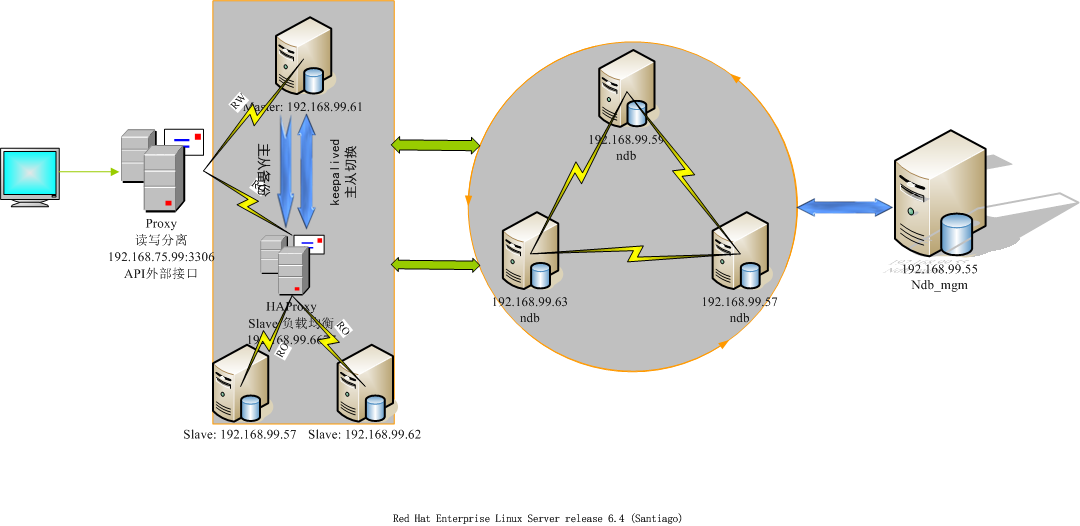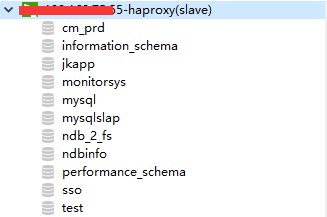
下面要执行的是HAProxy部分
这是一个集群,其他的部分在:
mysql-slave负载均衡[高可用]

1.安装haproxy
tar zxvf haproxy-1.4.13.tar.gz cd haproxy-1.4.13/ mkdir -p /usr/local/haproxy make TARGET=linux26 PREFIX=/usr/local/haproxy ##我的系统内核为2.6,所以target=linux26 make install PREFIX=/usr/local/haproxy
2.配置文件
mkdir /etc/haproxy touch /etc/haproxy/haproxy.cfg vim /etc/haproxy/haproxy.cfg
haproxy.cfg
global
log 127.0.0.1 local2
chroot /var/lib/haproxy
pidfile /var/run/haproxy.pid
maxconn 4000
user haproxy
group haproxy
daemon
stats socket /var/lib/haproxy/stats
defaults
mode tcp
log global
option dontlognull
option redispatch
retries 3
timeout http-request 10s
timeout queue 1m
timeout connect 10s
timeout client 1m
timeout server 1m
timeout http-keep-alive 10s
timeout check 10s
maxconn 600
listen stats
mode http
bind :6677
stats enable
stats hide-version
stats uri /haproxyadmin?stats
stats realm Haproxy Statistics
stats auth admin:admin
stats admin if TRUE
frontend main 192.168.99.55:9090
default_backend mysql
backend mysql
balance leastconn
server slave75.57 192.168.99.57:3306 check port 3306 maxconn 300
server slave75.62 192.168.99.62:3306 check port 3306 maxconn 300
haproxy服务脚本
#!/bin/sh
#
# haproxy
#
# chkconfig: - 85 15
# description: HAProxy is a free, very fast and reliable solution
# offering high availability, load balancing, and
# proxying for TCP and HTTP-based applications
# processname: haproxy
# config: /etc/haproxy/haproxy.cfg
# pidfile: /var/run/haproxy.pid
# Source function library.
. /etc/rc.d/init.d/functions
# Source networking configuration.
. /etc/sysconfig/network
# Check that networking is up.
[ "$NETWORKING" = "no" ] && exit 0
exec="/usr/sbin/haproxy"
prog=$(basename $exec)
[ -e /etc/sysconfig/$prog ] && . /etc/sysconfig/$prog
cfgfile=/etc/haproxy/haproxy.cfg
pidfile=/var/run/haproxy.pid
lockfile=/var/lock/subsys/haproxy
check() {
$exec -c -V -f $cfgfile $OPTIONS
}
start() {
$exec -c -q -f $cfgfile $OPTIONS
if [ $? -ne 0 ]; then
echo "Errors in configuration file, check with $prog check."
return 1
fi
echo -n $"Starting $prog: "
# start it up here, usually something like "daemon $exec"
daemon $exec -D -f $cfgfile -p $pidfile $OPTIONS
retval=$?
echo
[ $retval -eq 0 ] && touch $lockfile
return $retval
}
stop() {
echo -n $"Stopping $prog: "
# stop it here, often "killproc $prog"
killproc $prog
retval=$?
echo
[ $retval -eq 0 ] && rm -f $lockfile
return $retval
}
restart() {
$exec -c -q -f $cfgfile $OPTIONS
if [ $? -ne 0 ]; then
echo "Errors in configuration file, check with $prog check."
return 1
fi
stop
start
}
reload() {
$exec -c -q -f $cfgfile $OPTIONS
if [ $? -ne 0 ]; then
echo "Errors in configuration file, check with $prog check."
return 1
fi
echo -n $"Reloading $prog: "
$exec -D -f $cfgfile -p $pidfile $OPTIONS -sf $(cat $pidfile)
retval=$?
echo
return $retval
}
force_reload() {
restart
}
fdr_status() {
status $prog
}
case "$1" in
start|stop|restart|reload)
$1
;;
force-reload)
force_reload
;;
check)
check
;;
status)
fdr_status
;;
condrestart|try-restart)
[ ! -f $lockfile ] || restart
;;
*)
echo $"Usage: $0 {start|stop|status|restart|try-restart|reload|force-reload}"
exit 2
esac
3.启动
service haproxy start netstat -tlnp | grep haproxy tcp 0 0 0.0.0.0:6677 0.0.0.0:* LISTEN 32360/haproxy tcp 0 0 192.168.75.55:9090 0.0.0.0:* LISTEN 32360/haproxy ps aux | grep haproxy haproxy 32360 0.0 0.0 14416 1524 ? Ss 15:12 0:00 /usr/sbin/haproxy -D -f /etc/haproxy/haproxy.cfg -p /var/run/haproxy.pid root 32685 0.0 0.0 103244 840 pts/1 S+ 15:32 0:00 grep haproxy
4.检测
4.1浏览器
浏览器地址栏: http://192.168.99.55:6677/haproxyadmin?stats
上面的这个配置在haproxy.cfg里面

4.2navicat
 第一次连接连的是62
第一次连接连的是62 关闭, 重新连接
关闭, 重新连接 这次连的是57
这次连的是57
看数据库不同从而分析, 成功!
完毕!